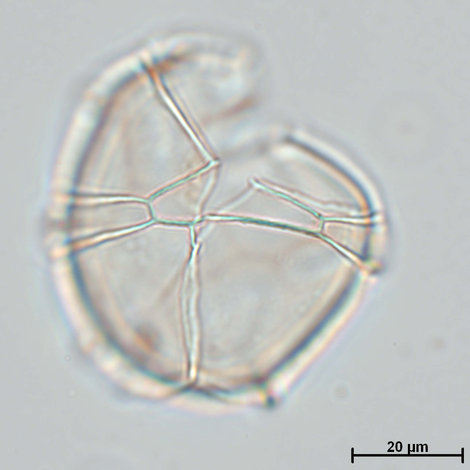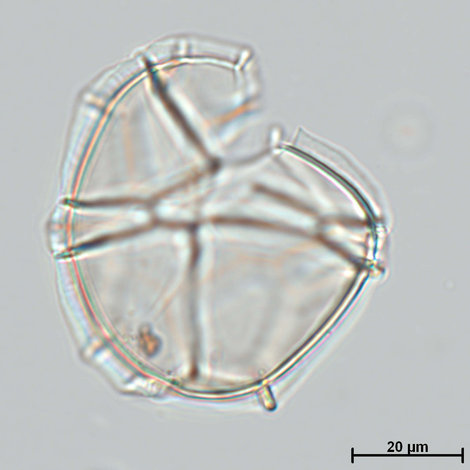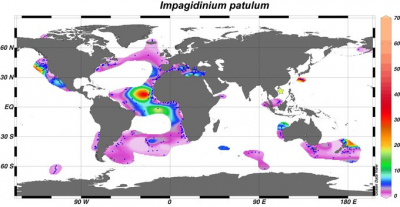Die Inhalte dieser Seite sind leider nicht auf Deutsch verfügbar.
Seitenpfad:
- Modern Dinocyst Key
- transparent cysts
- Paratabulation reflected by septa
- low septa of uniform height
- Impagidinium patulum
Impagidinium patulum
Zonneveld, K.A.F. and Pospelova V. (2015). A determination key for modern dinoflagellate cysts. Palynology 39 (3), 387- 407.

lateral view
photo: Karin Zonneveld
photo: Karin Zonneveld

cross section
photo: Karin Zonneveld
photo: Karin Zonneveld
Field Characteristics
Impagidinium patulum (Wall 1967) Stover et Evitt 1978
Field characteristics:
A large proximochorate cyst of ovoid shape with a smooth to weakly microgranulate wall surface. Tabulation is defined by low and well-expressed sutural septa with exception of the sulcal area where sutural septa are reduced. Furthermore, sutures are absent between between plate 5” and the sulcus. Archeopyle is precingular (type P).
Dimensions: Cyst body: 47 x 65 µm; height of septa: 2.5 to 7 µm.
Motile affinity: Probably a cyst of Gonyaulax spp.
Stratigraphic range: Lower Miocene to Recent.
Comparison with other species:
This species is much more robust as the other Impagidinium species. It is often large and its colour can be a little bit yellowish. The septa are smooth and robust. The complete tabulation is reflected with exception of the septa between the cingulum and plate 6” (also the sulcal region is not reflected). Its wall is not granulated like in I. paradoxum, but smooth.
Field characteristics:
A large proximochorate cyst of ovoid shape with a smooth to weakly microgranulate wall surface. Tabulation is defined by low and well-expressed sutural septa with exception of the sulcal area where sutural septa are reduced. Furthermore, sutures are absent between between plate 5” and the sulcus. Archeopyle is precingular (type P).
Dimensions: Cyst body: 47 x 65 µm; height of septa: 2.5 to 7 µm.
Motile affinity: Probably a cyst of Gonyaulax spp.
Stratigraphic range: Lower Miocene to Recent.
Comparison with other species:
This species is much more robust as the other Impagidinium species. It is often large and its colour can be a little bit yellowish. The septa are smooth and robust. The complete tabulation is reflected with exception of the septa between the cingulum and plate 6” (also the sulcal region is not reflected). Its wall is not granulated like in I. paradoxum, but smooth.
Geographic Distribution
Geographic distribution based on :
Zonneveld et al., 2013. Atlas of modern dinoflagellate cyst distribution based on 2405 datapoints. Review of Palaeobotany and Palynology, v. 191, 1-197
Zonneveld et al., 2013. Atlas of modern dinoflagellate cyst distribution based on 2405 datapoints. Review of Palaeobotany and Palynology, v. 191, 1-197
Impagidinium patulum has a temperate to equatorial distribution although it can be sporadically recorded in sub-polar and polar regions. It is restricted to full-marine environments. Although it can be observed in both oligotrophic to eutrophic environments and in shallow-coastal to the open ocean regions, highest relative abundances of this species occur in the central oceans with low upper water productivity and well ventilated bottom waters.

Distribution:
With a few exceptions of samples in the Beaufort Sea, the Bering Sea and near Antarctica, the distribution of Impagidinium patulum is restricted to temperate to equatorial full-marine regions between the sub-tropical frontal systems on both hemispheres. Although it can be observed in coastal sites, highest relative abundances up to 62% of the association can be observed in the central parts of the oceans such as the equatorial Atlantic and tropical western Pacific.
Environmental parameters:
SST: -2.0 - 29.6°C (winter - spring). SSS: 25.6 - 39.4 (summer - autumn), [P]: 0.06 - 1.87 μmol/l, [N]: 0.04 - 25.8 μmol/l, chlorophyll-a: 0.05- 4.6 ml/l, bottom water [O2]: > 1.7 ml/l except for two recordings.
Highest relative abundances of more than 10% can be observed in regions with temperatures between 12.0 - 28.4°C (winter - summer). I. patulum occurs in oligotrophic to eutrophic regions where chlorophyll-a concentrations are relatively low. The majority of the recordings and highest relative abundances are observed in oligotrophic environments of the central oceans.
Comparison with other records:
Apart from the recordings in this Atlas I. patulum has been documented from the South China Sea (see references in Zonneveld and Marret, 2003). In records other than those included in our dataset, highest relative abundances can be observed in sites where oligotrophic environments prevail although I. patulum does not avoid mesotrophic to eutrophic environments. So far only one sediment trap study reports the seasonal production of these cysts from the upwelling area off NW Africa. In this region cyst production increases when nutrient availability in upper waters is enhanced (Zonneveld et al., 2010)
With a few exceptions of samples in the Beaufort Sea, the Bering Sea and near Antarctica, the distribution of Impagidinium patulum is restricted to temperate to equatorial full-marine regions between the sub-tropical frontal systems on both hemispheres. Although it can be observed in coastal sites, highest relative abundances up to 62% of the association can be observed in the central parts of the oceans such as the equatorial Atlantic and tropical western Pacific.
Environmental parameters:
SST: -2.0 - 29.6°C (winter - spring). SSS: 25.6 - 39.4 (summer - autumn), [P]: 0.06 - 1.87 μmol/l, [N]: 0.04 - 25.8 μmol/l, chlorophyll-a: 0.05- 4.6 ml/l, bottom water [O2]: > 1.7 ml/l except for two recordings.
Highest relative abundances of more than 10% can be observed in regions with temperatures between 12.0 - 28.4°C (winter - summer). I. patulum occurs in oligotrophic to eutrophic regions where chlorophyll-a concentrations are relatively low. The majority of the recordings and highest relative abundances are observed in oligotrophic environments of the central oceans.
Comparison with other records:
Apart from the recordings in this Atlas I. patulum has been documented from the South China Sea (see references in Zonneveld and Marret, 2003). In records other than those included in our dataset, highest relative abundances can be observed in sites where oligotrophic environments prevail although I. patulum does not avoid mesotrophic to eutrophic environments. So far only one sediment trap study reports the seasonal production of these cysts from the upwelling area off NW Africa. In this region cyst production increases when nutrient availability in upper waters is enhanced (Zonneveld et al., 2010)


